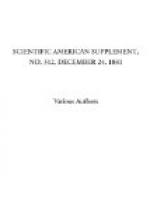The saw table has an inserted portion, C, held in place by two screws which may be removed when it is desired to use the saw mandrel for carrying a sticker head for planing small strips of moulding or reeding. The head for holding the moulding knives is best made of good tough brass or steam metal. The knives can be made of good saw steel about one-eighth inch thick. They may be filed into shape and afterward tempered. They are slotted and held to their places on the head by means of quarter-inch machine screws. It is not absolutely necessary to use two knives, but when only one is employed a counterbalance should be fastened to the head in place of the other. All kinds of moulding, beading, tonguing, and grooving may be done with this attachment, the gauge being used to guide the edge of the stuff. If the boards are too thin to support themselves against the action of the knives they must be backed up by a thick strip of wood planed true. The speed for this cutter head should be as great as possible.
Fig. 5 shows an attachment to be used in connection with the cutter head and saw table for cutting straight, spiral, or irregular flutes on turned work. It consists of a bar, D, carrying a central fixed arm, and at either end an adjustable arm, the purpose of the latter being to adapt the device to work of different lengths. The arm projecting from the center of the bar, D, supports an arbor having at one end a socket for receiving the twisted iron bar, E, and at the other end a center and a short finger or pin. A metal disk having three spurs, a central aperture, and a series of holes equally distant from the center and from each other, is attached by its spurs to the end of the cylinder to be fluted, and the center of the arbor in the arm, D, enters the central hole in the disk while its finger enters one of the other holes. The opposite end of the cylinder is supported by a center screw. A fork attached to the back of the table embraces the twisted iron, E, so that as the wooden cylinder is moved diagonally over the cutter it is slowly rotated, making a spiral cut. After the first cut is made the finger of the arbor is removed from the disk and placed in an adjoining hole, when the second cut is made, and so on.
Figs. 6 and 7 show a convenient and easily made attachment for moulding the edges of irregular work, such as brackets, frames, parts of patterns, etc. It consists of a brass frame, F, supporting a small mandrel turning at the top in a conical bearing in the frame, and at the bottom upon a conical screw. A very small grooved pulley is fastened to the mandrel and surrounded by a rubber ring which bears against the face plate of the lathe, as shown in the engraving. The frame, F, is let into a wooden table supported by an iron rod which is received by the tool rest holder of the lathe. The cutter, G, is made by turning upon a piece of steel the reverse of the required moulding, and slotting it transversely to form cutting edges. The shank of the cutter is fitted to a hole in the mandrel and secured in place by a small set screw. The edge of the work is permitted to bear against the shank of the cutter. Should the face plate of the lathe be too small to give the required speed, a wooden disk may be attached to it by means of screws and turned off.




